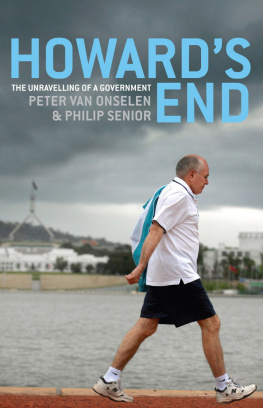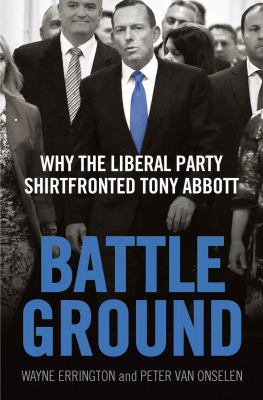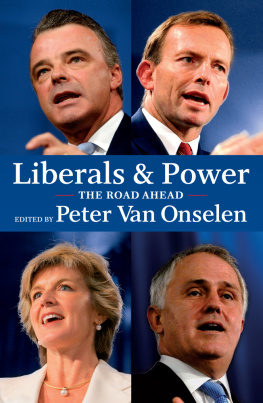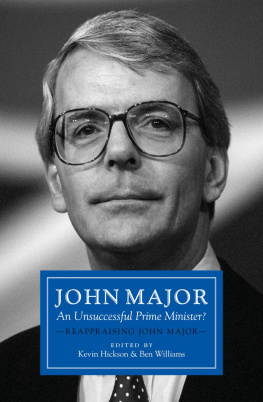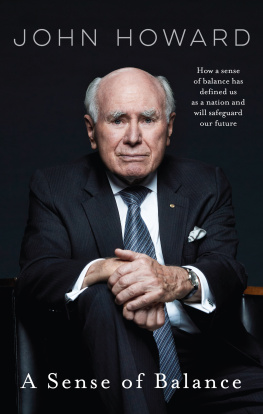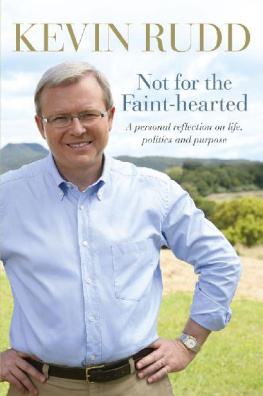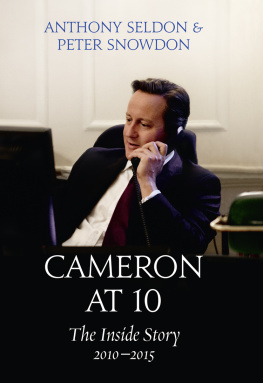Introduction
Only when the Queensland results started to trickle in after 7 p.m. Sydney time, indicating a landslide swing to Labor, did John Howard concede the election was lost. Well, thats it, then, he calmly told his family. He took a notepad and pen from the study at Kirribilli and started jotting some ideas for his concession speech.
Even as the Coalitions campaign had unravelled in the final days of the campaign, Howard had still believed he might be able to scrape home with a strong showing in marginal seats. This was the first time he had allowed himself to consider what he would say if he lost.
The downfall of John Winston Howard and his government came as no surprise on the night of the federal election, 24 November 2007. The Liberal Party had trailed the Labor Party in opinion polls all year. Howard and his team of ministers had looked all at sea for many months, while Opposition Leader Kevin Rudds personal approval ratings were stratospheric. In his time as prime minister, Howard had seen off three different Labor leaders. When Rudd won the Labor leadership from Kim Beazley in December 2006, many thought he would be number four. Labor had led in the polls for much of Beazleys stint as leader, but with the economy firing on all cylinders, the stage looked set for Howard to come from behind as he had in 2001 and 2004.
However, the Coalitions situation was more precarious than most realised. Beazleys failure to resonate with the public was suppressing Labors vote, and the extent of the mood for change was hidden. As Rudd settled in, and his personal approval ratings soared, the Coalition began to look like it could be beaten.
The Coalition government was tired after eleven years at the helm, and Howard was looking his 67-plus years. His key ministers Treasurer Peter Costello and Foreign Affairs Minister Alexander Downer among themseemed stale in the jobs to which they had been appointed in 1996, when the government was first elected. When leadership tensions between Howard and his treasurer began to flare again in July 2007, the governments faltering image of stability and sure-handedness was further damaged. The contrast with a rejuvenated Labor could not have been starker: Rudd was young, energetic and, importantly, well known and well skilled in the art of politics. His team members put aside their differences and presented a united front. They were helped along by a restless press gallery, who, like the public, seemed ready for a change of government.
In many ways, the government was a victim of its own success, with the 2004 federal election result sowing the seeds of its demise. Mark Latham, Labors first attempt at generational change, had taken the fight to Howard, leading him for large parts of the election year. But, ultimately, he presented as too risky a proposition. In the aftermath of defeat, Latham imploded and stormed off to compile his diaries, the release of which damaged the new Labor leader, Kim Beazley, a return to the past if ever there was one. Remarkably, Howard had increased the Coalitions majority for the second straight election, the first time a prime minister had ever accomplished this feat.
At his first party-room meeting after the victory, Howard cautioned his MPs about overconfidence. He warned that in three years time, the electoral map might look very different. They must be diligent, he said, and engage in what he described as a perpetual campaign after all, governments rarely win fifth terms (it had happened only twice in the countrys history). But the words barely registered with elated MPs, and arrogance crept in even as they rejoiced. The remarkable victory had also delivered the Howard government control of the Senate, the final check on partisan extremism within its ranks. It would prove to be a poisoned chalice. Howard used his Senate majority to push through a new wave of workplace reformsthey would collectively become known as WorkChoices, and were significant in sealing the governments fate. Despite his excellent political antennae, Howard was blind to the danger because of his ideological commitment through a lifetime in politics to industrial relations reform.
Howards long-term chief of staff, Arthur Sinodinos, said that the former prime minister was at his best when he was fighting for something he believed in. That was the case when he fell over the line at the 1998 election, arguing in favour of a GST. Howard himself had said that there was little he enjoyed more than watching unpopular policy grow to the point of public acceptance. And so he hoped that three years would give the Liberal Party enough time to sell WorkChoices to a sceptical electorate. It didnt happen. The legislation took too long to be drafted, and then the first minister given responsibility for it, Kevin Andrews, was replaced in early 2007. Government advertising campaigns designed to soften public attitude only played into Labors hands, as the (mis)use of taxpayer funds to sell a partisan message rubbed voters the wrong way. And, of course, there was the union-funded scare campaign, one of the most expensive and successful in Australian political history. Beazley also deserves his fair share of the credit. Whatever his failings as Opposition leader, between 2005 and 2007 Beazley confirmed one thing in voters mindsWorkChoices went too far. A Labor government would rip it up and restore fairness to the IR system. Rudd was clever enough not to stray from that message, instead choosing to build on it by articulating important differences with the government over climate change and education.
Howards antennae also failed him in the area of climate change. He had long opposed ratification of the Kyoto Protocol, and his government contained many climate change sceptics. This position was tenable in 2004, but by 2007 things had changed. There had been a dramatic shift in public opinion concerning the threat of climate change, due in large part to the influence of Al Gores film An Inconvenient Truth. For many Australians, climate change was now the most important issue on the political agenda. Yet Howard and his team were too slow to recognise this.
In 2004, the war in Iraq was unpopular, but the removal of Saddam Hussein was still fresh in peoples minds, reducing animosity towards the governments decision to participate in the invasion. By 2007, Australias ongoing involvement in the conflict was a more difficult sell. Uncertainty as to how, or when, the war might end made Rudds commitment to withdraw Australian troops contrast nicely with Howards unquestioning support of George W Bush.
Similarly, the ongoing incarceration of David Hicks at Guantnamo Bay in Cuba was not initially something that the Howard government cared to question much. In the immediate aftermath of the September 11 2001 attacks, there was little sympathy for Hicks. But as the years rolled on, public interest in his release grew, so much so that by 2007, the Howard government was seen as negligent by not having negotiated his return to Australia. Howard didnt seem to understand that just because the public thought Hicks was a ratbag, that didnt mean they wanted him to rot in a cell without a fair trial. By the time the government decided it would use its well-earned political capital with the United States to bring Hicks home, the perception of a government out of touch with changing community attitudes was well entrenched.
The prominence of interest rates in the 2004 campaign also presented a headache for Howard in his bid for a fifth term. When announcing that election, Howard posed the direct question, Who do you trust to keep interest rates low? The Coalitions message was that, if elected,

